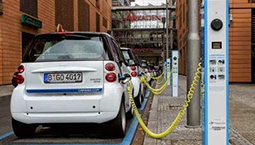Quality-oriented, Customer satisfaction
SOLUTION

Heat radiation solutions to the new energy...
In recent years, the production and sales of new energy cars in China have grown rapidly, and the synergistic effect of various supporting policies of central and local governments has been fully developed. According to the proposal in the Development Guide of Electric Vehicle Charging Facilities (2015-2020), issued by the National Development and Reform Commission and other three departments on November 17, 2015, over 12,000 centralized charging and changing stations will be increased, and over 4,800,000 distributed charging piles will be increased by 2020 so as to meet the charging needs of 5 million electric vehicles throughout the country. The construction investment of charging facilities will reach RMB 124 billion, and the market will have a huge development opportunity.
Compared to other power supplies, the system heat radiation of charging piles is much larger, and the requirement for system thermal design is very strict. The power range of DC charging pile is 30 KW, 60 KW and 120 KW, and the efficiency is generally around 95%, so the other 5% is converted into heat loss, which will be 1.5 KW, 3 KW and 6 KW. As for outdoor equipment, these heat must be discharged out of the equipment, otherwise, it will make the equipment aging quickly. In the meantime, the processing of waterproof and dustproof is also necessary, so as to prevent the short circuit and signal disorder of the electronic equipment.
There are four common cooling methods at present: natural cooling (mainly by air cooling fin), forced air cooling, water cooling, and air conditioning. Due to influence of volume, cost, reliability and other factors, most companies use forced air cooling. So, it is bound to bring dust, corrosive gas, moisture or other interference. The heat radiation of charging pile is divided into parts: module heat radiation and chassis overall radiation. the charging module is built inside, so the protective measures are mainly taken to the chassis design. The most simple and economic design is to make it be the shutter at air inlet and outlet of the box, and then add the fan at air outlet to pump out the heat discharged by the module fan. See the picture below:
There are four common cooling methods at present: natural cooling (mainly by air cooling fin), forced air cooling, water cooling, and air conditioning. Due to influence of volume, cost, reliability and other factors, most companies use forced air cooling. So, it is bound to bring dust, corrosive gas, moisture or other interference. The heat radiation of charging pile is divided into parts: module heat radiation and chassis overall radiation. the charging module is built inside, so the protective measures are mainly taken to the chassis design. The most simple and economic design is to make it be the shutter at air inlet and outlet of the box, and then add the fan at air outlet to pump out the heat discharged by the module fan. See the picture below:
.png)
This method can have a certain protective effect, but there will be dust and moisture after a long time. If you want a better protective effect, you can adopt the enclosed cold and hot isolation air duct to conduct cold and hot isolation to the inside (as shown below): completely separate the cold and hot fluid by the medium septum, cool it efficiently through the heat carrier and the top fan and select the shutter screen pack at the air inlet and outlet for effective waterproof and dustproof.
.png)
Operating principle of heat carrier: heat carrier consists of shell and tube, wick, end cover and fins. Pump the tube to negative pressure of 1.3 x (10-1 ~ 10-4) Pa and then fill it with the proper amount of operating liquid, and finally seal the wick close to the wall of inner tube after the capillary porous material is full of the liquid. One end of the tube is evaporator section (heating section) and the other end is condenser section (cooling section); and adiabatic section can be arranged in the middle of these two sections according to application needs. When one end of the heat pipe is heated, the liquid in fur threading core will be vaporized, the steam under the tiny pressure will flow to the other end to release heat and condense into liquid, and then the liquid along the porous material will flow back to evaporator section by capillary force. According to this circulation, the heat will transfer from one end of the tube to the other, and the top fan will take the heat away.



 Friendly links:
Friendly links: 
